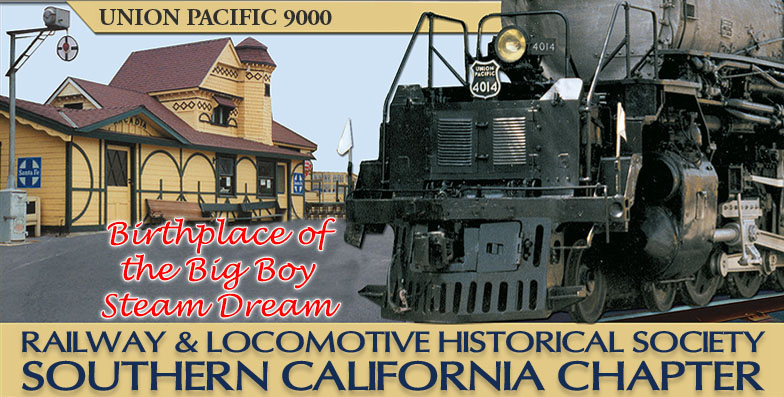Union Pacific 9000
A Brief History Of This Engine

Union Pacific locomotive number 9000 has a 4-12-2 wheel arrangement, is classified as a “Union Pacific” type, and was designed for heavy freight service. This class is the largest steam locomotive built on a rigid frame and it has a wheelbase of over 30 feet. Its 12 drive wheels are powered by three massive cylinders, one of which is located inside the frame, which transmits its power through a crankshaft on the second driver axle. The two outside cylinders are connected by conventional main and segmented side rods to the third driver. This class was nicknamed “the 9s” because nine wheels are on each side.
Number 9000 saw continuous service for almost 30 years and was used mainly to haul freight between Ogden, Utah and Council Bluffs, Iowa. Number 9000 was donated by Union Pacific Railroad to The Railway and Locomotive Historical Society, Southern California Chapter in May of 1956, and arrived under its own steam power in Union Pacific’s East Los Angeles yard, where its fire was dropped. It was subsequently towed to the Los Angeles County Fairgrounds by Southern Pacific and Pacific Electric railroads.
Union Pacific No. 9000 is the prototype of the class Not only was it the first built in the class, but also the last retired of this type. It was built in 1926 and is the only survivor of the entire class of 88 similar locomotives built for Union Pacific. It is one of four surviving three-cylinder steam locomotives built in the United States. Another surviving three-cylinder locomotive is Southern Pacific No. 5021, which is also on display at RailGiants Train Museum.

“Up” In Wyoming
Wyoming’s place in railroad history is secure, and the opportunities for watching trains and train crews in action are legend. Southern Wyoming’s development is linked with the Union Pacific Railroad. It laid tracks westward across the state in 1867 and ‘68 in a race to build the first transcontinental railroad. Settlements sprang up virtually overnight to house legions of workers. Some were abandoned. Others became permanent communities.
Towns grew up as fast as workers could lay track westward to Laramie, Rawlins, Rock Springs and Evanston. Elsewhere in the state, smaller lines were also built. Nine historic Wyoming depots are now museums dedicated to railroad history. Green River in the southwestern corner boasts busy Union Pacific rail yard and the 1910 depot, now used for offices.
While the Union Pacific is the dominant east/west railroad, BNSF is the main north/south line. Between them, they haul the more than 400 million tons of low-sulfur coal produced annually in Wyoming, the nation’s number-one coal state, to the nation’s hungry electricity-generating plants. Roughly a quarter of this output comes from ten huge mines in the Powder River Basin, south of Gillette. The UP and BNSF jointly own the rail line out of the coalfields, parallel to Highway 59 and are rapidly laying more tracks to keep up with the demand for coal. When the trains, each up to 1½ mile long, reach the North Platte River, the tracks split. Gillette, founded in 1891, was named after Edward Gillette, a railroad surveyor and engineer. If he were around today, he’d surely find work on the new tracks.
![]() Click on the PDF icon to open your copy of our Union Pacific #9000 Brochure.
Click on the PDF icon to open your copy of our Union Pacific #9000 Brochure.




